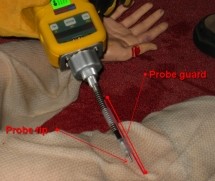Back to Journals » Open Access Emergency Medicine » Volume 1
The use of a photoionization detector to detect harmful volatile chemicals by emergency personnel
Authors Patel N, Fales W, Farrell
Published 22 September 2009 Volume 2009:1 Pages 5—9
DOI https://doi.org/10.2147/OAEM.S6855
Review by Single anonymous peer review
Peer reviewer comments 2

Neil D Patel1, William D Fales1, Robert N Farrell1,2
1Michigan State University, Kalamazoo Center for Medical Studies, Kalamazoo, MI, USA; 2Portage Fire Department, Portage, MI, USA
Objective: The objective of this investigation was to determine if a photoionization detector (PID) could be used to detect the presence of a simulated harmful chemical on simulated casualties of a chemical release.
Methods: A screening protocol, based on existing radiation screening protocols, was developed for the purposes of the investigation. Three simulated casualties were contaminated with a simulated chemical agent and two groups of emergency responders were involved in the trials. The success–failure ratio of the participants was used to judge the performance of the PID in this application.
Results: A high success rate was observed when the screening protocol was properly adhered to (97.67%). Conversely, the success rate suffered when participants deviated from the protocol (86.31%). With one exception, all failures were noted to have been the result of a failure to correctly observe the established screening protocol.
Conclusions: The results of this investigation indicate that the PID may be an effective screening tool for emergency responders. However, additional study is necessary to both confirm the effectiveness of the PID and refine the screening protocol if necessary.
Keywords: prehospital, device, protocol, photoionization detectors
 © 2009 The Author(s). This work is published and licensed by Dove Medical Press Limited. The full terms of this license are available at https://www.dovepress.com/terms.php and incorporate the Creative Commons Attribution - Non Commercial (unported, v3.0) License.
By accessing the work you hereby accept the Terms. Non-commercial uses of the work are permitted without any further permission from Dove Medical Press Limited, provided the work is properly attributed. For permission for commercial use of this work, please see paragraphs 4.2 and 5 of our Terms.
© 2009 The Author(s). This work is published and licensed by Dove Medical Press Limited. The full terms of this license are available at https://www.dovepress.com/terms.php and incorporate the Creative Commons Attribution - Non Commercial (unported, v3.0) License.
By accessing the work you hereby accept the Terms. Non-commercial uses of the work are permitted without any further permission from Dove Medical Press Limited, provided the work is properly attributed. For permission for commercial use of this work, please see paragraphs 4.2 and 5 of our Terms.
